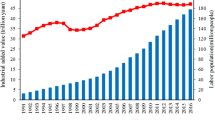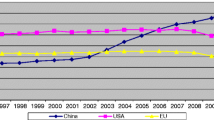Abstract
Continual growth of energy-related CO2 emissions in China has received great attention, both domestically and internationally. In this paper, we evaluated the CO2 emissions in five major energy consumption sectors which were evaluated from 1991 to 2012. In order to analyze the driving factors of CO2 emission change in different sectors, the Kaya identity was extended by adding several variables based on specific industrial characteristics and a decomposition analysis model was established according to the LMDI method. The results demonstrated that economic factor was the leading force explaining emission increase in each sector while energy intensity and sector contribution were major contributors to emission mitigation. Meanwhile, CO2 emission intensity had no significant influence on CO2 emission in the short term, and energy consumption structure had a small but growing negative impact on the increase of CO2 emissions. In addition, the future CO2 emissions of industry from 2013 to 2020 under three scenarios were estimated, and the reduction potential of CO2 emissions in industry are 335 Mt in 2020 under lower-emission scenario while the CO2 emission difference between higher-emission scenario and lower-emission scenario is nearly 725 Mt. This paper can offer complementary perspectives on determinants of energy-related CO2 emission change in different sectors and help to formulate mitigation strategies for CO2 emissions.




Similar content being viewed by others
References
Ang BW (2004) Decomposition analysis for policymaking in energy: which is the preferred method? Energy Policy 32:1131–1139
Ates SA, Durakbasa NM (2012) Evaluation of corporate energy management practices of energy intensive industries in Turkey. Energy 45:81–91
Butt TE, Giddings RD, Jones KG (2012) Environmental sustainability and climate change mitigation—CCS technology, better having it than not having it at all! Environ Prog Sustainable Energy 31:642–649
Crompton P, Wu Y (2005) Energy consumption in China: past trends and future directions. Energ Econ 27:195–208
EIA (2013) Total carbon dioxide emissions from the consumption of energy (million metric tons). International Energy Statistics
Gui S, Mu H, Li N (2014) Analysis of impact factors on China’s CO2 emissions from the view of supply chain paths. Energy 74:405–416
Guo YG, Lin FC, Bai YQ, et al. (2009) The decomposition research on energy-related carbon emissions of Shanghai. Chin J Environ Pollut Prot 31:68–72
Gurney KR (2009) Global change: China at the carbon crossroads. Nature 458:977–979
Jung S, An KJ, Dodbiba G, Fujita T (2012) Regional energy-related carbon emission characteristics and potential mitigation in eco-industrial parks in South Korea: logarithmic mean Divisia index analysis based on the Kaya identity. Energy 46:231–241
Kaya Y (1989) Impact of carbon dioxide emission on GNP growth: interpretation of proposed scenarios. In: Presentation to the Energy and Industry Subgroup, Response Strategies Working Group. IPCC, Paris
Kim RH, Tae SH, Yang KH, Kim TH (2014) Analysis of lifecycle CO2 reduction performance for long-life apartment house. Environ Prog Sustainable Energy 34:555–566
Kuo NW, Lin CY, Chen PH, Chen YW (2012) An inventory of the energy use and carbon dioxide emissions from island tourism based on a life cycle assessment approach. Environ Prog Sustainable Energy 31:459–465
Lin BQ, Liu XY (2010) China’s carbon dioxide emissions under the urbanization process: influence factors and abatement policies. Econ Res J 8:66–78
Lin B, Moubarak M (2013) Decomposition analysis: change of carbon dioxide emissions in the Chinese textile industry. Renew Sust Energ Rev 26:389–396
Lin B, Ouyang X (2014a) Analysis of energy-related CO2 (carbon dioxide) emissions and reduction potential in the Chinese non-metallic mineral products industry. Energy 68:688–697
Lin B, Ouyang X (2014b) Energy demand in China: comparison of characteristics between the US and China in rapid urbanization stage. Energy Convers Manag 79:128–139
Liu Z, Geng Y, Lindner S, Guan D (2012) Uncovering China’s greenhouse gas emission from regional and sectoral perspectives. Energy 45:1059–1068
National Bureau of Statistics (2010) China energy statistical yearbook 2006–2010. China Statistics Press, Beijing
National Bureau of Statistics (2013) China energy statistical yearbook 1991–2012. China Statistics Press, Beijing
Ou X, Zhang X, Chang S (2010) Scenario analysis on alternative fuel/vehicle for China’s future road transport: life-cycle energy demand and GHG emissions. Energ Policy 38:3943–3956
Shen L, Cheng S, Gunson AJ, Wan H (2005) Urbanization, sustainability and the utilization of energy and mineral resources in China. Cities 22:287–302
Song DY, Lu ZB (2009) The factor decomposition and periodic fluctuations of carbon emission in China. China Popul Resour Environ 19:18–24
Wang C, Zhang X, Wang F, et al. (2015) Decomposition of energy-related carbon emissions in Xinjiang and relative mitigation policy recommendations. Front Earth Sci 9:65–76
Wang F, Dong B, Yin X, An C (2014) China’s structural change: a new SDA model. Econ Model 43:256–266
Wang P, Wu W, Zhu B, et al. (2013) Examining the impact factors of energy-related CO 2 emissions using the STIRPAT model in Guangdong Province, China. Appl Energy 106:65–71
Zhang Q, Ishihara KN, Mclellan BC, Tezuka T (2012) Scenario analysis on future electricity supply and demand in Japan. Energy 38:376–385
Zhao C, Chen B, Hayat T, Alsaedi A, Ahmad B (2014) Driving force analysis of water footprint change based on extended STIRPAT model: evidence from the Chinese agricultural sector. Ecol Indic 47:43–49
Zhao M, Tan L, Zhang W, Ji M, Liu Y, Yu L (2010) Decomposing the influencing factors of industrial carbon emissions in Shanghai using the LMDI method. Energy 35:2505–2510
Acknowledgments
This research is supported by the China National Natural Science Foundation (no. 41301649).
Author information
Authors and Affiliations
Corresponding author
Additional information
Responsible editor: Gerhard Lammel
Rights and permissions
About this article
Cite this article
Cui, E., Ren, L. & Sun, H. Analysis of energy-related CO2 emissions and driving factors in five major energy consumption sectors in China. Environ Sci Pollut Res 23, 19667–19674 (2016). https://doi.org/10.1007/s11356-016-7081-7
Received:
Accepted:
Published:
Issue Date:
DOI: https://doi.org/10.1007/s11356-016-7081-7




